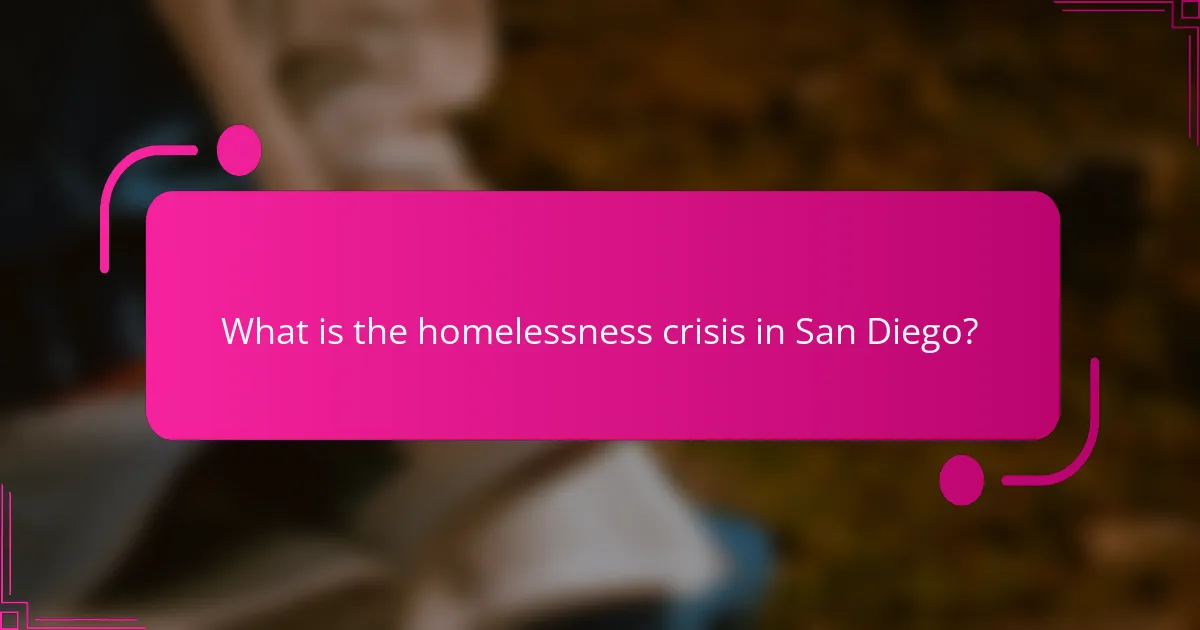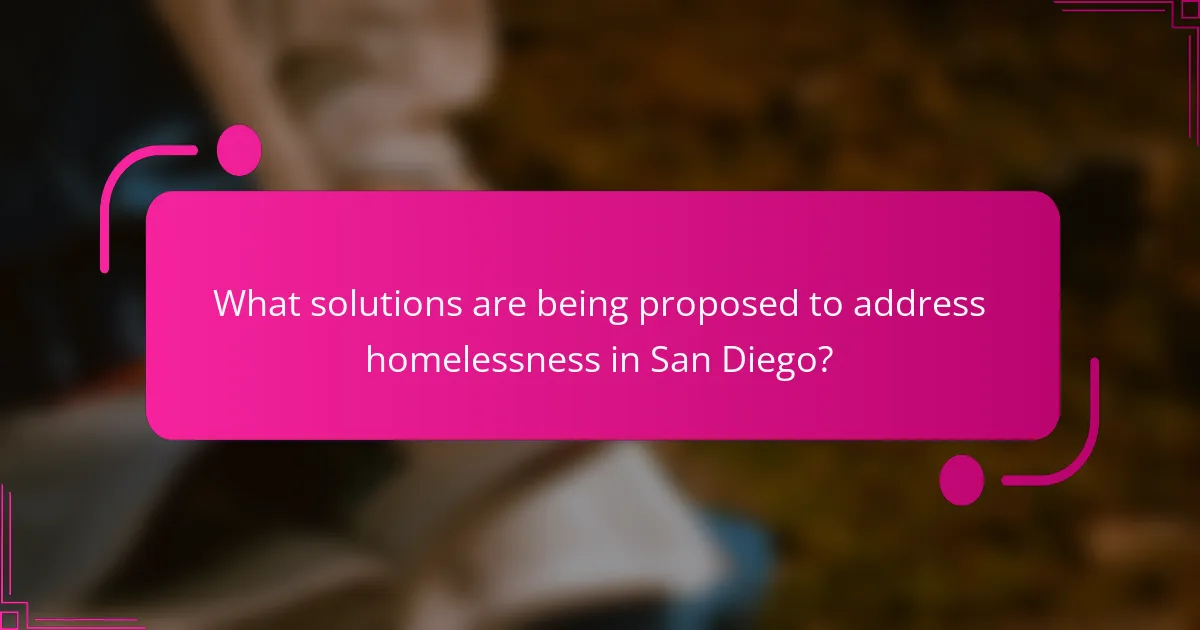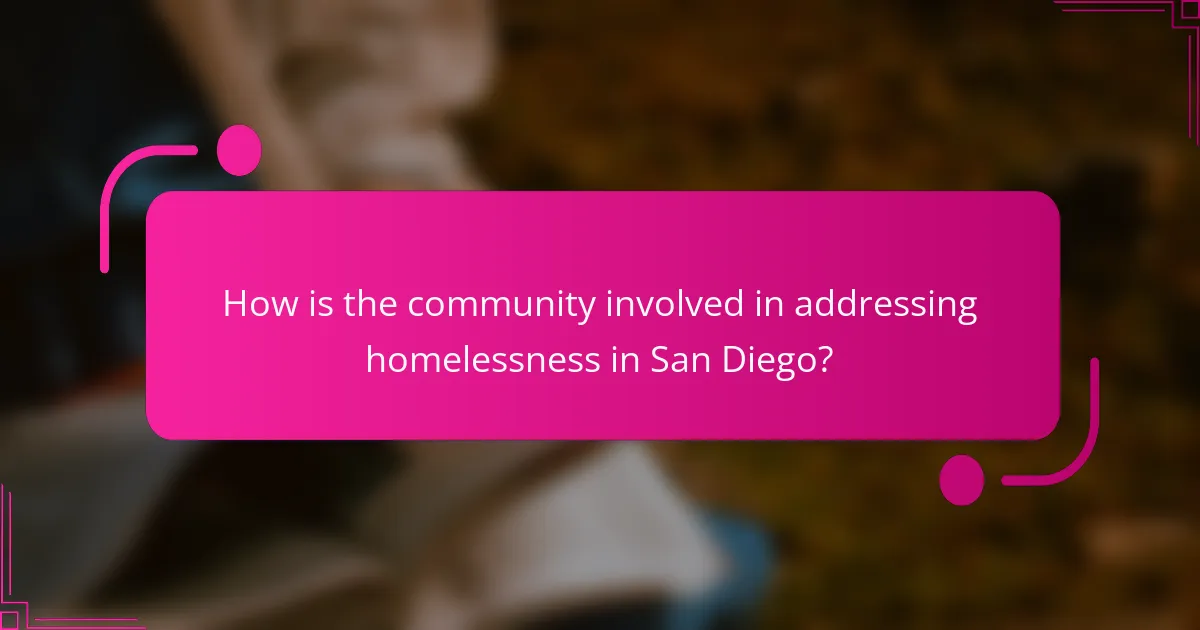
What is the homelessness crisis in San Diego?
The homelessness crisis in San Diego refers to the significant increase in individuals experiencing homelessness in the region. As of 2022, over 8,400 people were reported to be homeless in San Diego County. This figure marks a 10% rise from the previous year, indicating a growing concern. Contributing factors include high housing costs, lack of affordable housing, and mental health issues. Additionally, the COVID-19 pandemic exacerbated existing vulnerabilities. The city has implemented various initiatives to address the crisis, including temporary shelters and supportive housing programs. Community organizations also play a crucial role in providing resources and assistance to those in need.
What are the key statistics related to homelessness in San Diego?
As of 2023, approximately 8,427 individuals are experiencing homelessness in San Diego. This figure represents a 10% increase from the previous year. A significant portion, about 60%, are unsheltered, living on the streets or in vehicles. The homeless population includes 1,800 families with children. Additionally, 19% identify as veterans. The demographic breakdown shows that 67% are male and 33% are female. Mental health issues affect around 30% of the homeless population. Substance abuse disorders are reported in 20% of cases. These statistics highlight the ongoing homelessness crisis in San Diego and the need for targeted interventions.
How has the homeless population changed over recent years?
The homeless population in San Diego has increased in recent years. According to the 2022 Point-in-Time Count, there were approximately 8,427 homeless individuals. This represents a 10% rise from the previous year. Factors contributing to this increase include rising housing costs and economic instability. The COVID-19 pandemic further exacerbated these issues. Many individuals lost jobs and faced eviction. Additionally, the availability of affordable housing has diminished. These trends indicate a growing crisis that requires urgent attention and solutions.
What demographics are most affected by homelessness in San Diego?
The demographics most affected by homelessness in San Diego include single adults, families with children, and veterans. A significant portion of the homeless population consists of individuals aged 25 to 54. Data from the 2022 Point-in-Time Count indicates that 40% of the homeless population are unsheltered. Additionally, people of color, particularly Black and Latino individuals, are disproportionately represented among the homeless. The report shows that Black individuals make up 6% of the general population but nearly 30% of the homeless population. Furthermore, [censured] youth are also highly affected, with many experiencing homelessness due to family rejection. The combination of these demographics highlights the multifaceted nature of homelessness in San Diego.
What are the primary causes of homelessness in San Diego?
The primary causes of homelessness in San Diego include high housing costs, lack of affordable housing, and insufficient mental health services. The median rent in San Diego has increased significantly, making it difficult for low-income individuals to secure housing. According to the San Diego Housing Commission, over 50% of renters in San Diego are cost-burdened. Additionally, many individuals experiencing homelessness face mental health challenges. The National Alliance on Mental Illness reports that around 25% of the homeless population suffers from severe mental illness. Substance abuse issues also contribute to homelessness, with many individuals struggling with addiction. Unemployment and underemployment further exacerbate the situation, as job opportunities remain limited for those without stable housing. Finally, systemic issues such as discrimination and lack of supportive services hinder efforts to address homelessness effectively.
How do economic factors contribute to homelessness?
Economic factors significantly contribute to homelessness by affecting housing affordability and employment stability. High housing costs in areas like San Diego outpace income growth. Many individuals and families cannot afford rent or mortgage payments. Job loss or reduced working hours further exacerbates financial instability. The lack of affordable housing options increases competition for limited resources. Economic downturns can lead to higher unemployment rates, pushing more people into homelessness. According to the National Low Income Housing Coalition, there is a shortage of 7 million affordable rental homes for extremely low-income renters. This gap highlights the critical link between economic conditions and homelessness.
What role does mental health play in the homelessness crisis?
Mental health significantly contributes to the homelessness crisis. Many individuals experiencing homelessness face mental health disorders such as depression, anxiety, and schizophrenia. These conditions can impair their ability to maintain stable employment and housing. According to the National Alliance on Mental Illness, approximately 20% of the homeless population has a serious mental illness. This statistic highlights the strong correlation between mental health issues and homelessness. Additionally, untreated mental health problems can lead to substance abuse, further complicating the situation. Access to mental health services is often limited for those in homeless situations. As a result, individuals may cycle in and out of homelessness without receiving necessary support. Addressing mental health is crucial for effective solutions to the homelessness crisis.
How does the lack of affordable housing impact homelessness rates?
The lack of affordable housing directly increases homelessness rates. When housing costs exceed income levels, many individuals cannot secure stable living conditions. According to the National Low Income Housing Coalition, in 2021, there was a shortage of 7 million affordable homes for extremely low-income renters. This shortage forces individuals and families into precarious living situations or homelessness. Additionally, rising rents in urban areas contribute to this crisis. In San Diego, for example, the median rent has significantly outpaced wage growth. As a result, more people face eviction and displacement. This cycle perpetuates homelessness, making it a pressing issue for communities.

What solutions are being proposed to address homelessness in San Diego?
San Diego is proposing various solutions to address homelessness. These include increasing affordable housing availability. The city aims to build more permanent supportive housing units. Another solution involves expanding shelter options for those in need. San Diego plans to enhance outreach services to connect homeless individuals with resources. Additionally, the city is focusing on mental health and addiction services. Partnerships with non-profit organizations are being strengthened to provide comprehensive support. The proposed solutions also include job training programs to help individuals gain employment. These efforts are part of a broader strategy to reduce homelessness in the region.
What initiatives are currently in place to combat homelessness?
Numerous initiatives are currently in place to combat homelessness in San Diego. The City of San Diego has implemented the “Homelessness Action Plan,” which focuses on prevention, outreach, and housing solutions. This plan aims to reduce homelessness by 50% over five years. Additionally, the “Safe Parking Program” provides designated areas for individuals living in vehicles to park safely overnight.
The “Regional Task Force on Homelessness” coordinates efforts among various organizations and government agencies. They collect data and provide resources to support individuals experiencing homelessness. The “Homekey” program aims to convert hotels and motels into permanent supportive housing.
Moreover, the “Coordinated Entry System” streamlines access to services for those in need. This system ensures that individuals receive appropriate support based on their specific circumstances. These initiatives reflect a comprehensive approach to addressing homelessness in the region.
How effective are outreach programs in connecting individuals to services?
Outreach programs are highly effective in connecting individuals to services. Studies show that these programs significantly increase access to essential resources. For example, a report by the National Alliance to End Homelessness indicates that outreach efforts can lead to a 30% increase in service utilization among homeless populations. Additionally, outreach programs often provide immediate assistance, facilitating quicker access to housing and healthcare services. In San Diego, local outreach initiatives have successfully engaged thousands of individuals, linking them with necessary support systems. Data from the San Diego Regional Task Force on Homelessness reveals that outreach efforts have helped over 1,000 individuals secure permanent housing in the past year alone.
What role do temporary shelters play in providing immediate relief?
Temporary shelters provide essential immediate relief for individuals experiencing homelessness. They offer a safe space for individuals to rest and recover from the challenges of living on the streets. These shelters often provide access to basic necessities such as food, hygiene facilities, and medical care. By offering a temporary refuge, they help reduce exposure to harsh weather conditions and potential dangers.
Research indicates that shelters can significantly lower the risks of illness and injury among homeless populations. For example, a study by the National Alliance to End Homelessness found that shelter usage is linked to improved health outcomes. Furthermore, temporary shelters often serve as a gateway to longer-term housing solutions and support services. They connect individuals to resources such as job training and counseling, facilitating a path towards stability.
What long-term solutions are being considered for homelessness?
Long-term solutions being considered for homelessness include permanent supportive housing and affordable housing development. Permanent supportive housing combines affordable housing with supportive services. This approach has proven effective in reducing homelessness rates. Affordable housing development aims to increase the availability of low-income housing. Studies show that increasing affordable units can significantly decrease homelessness. Other solutions involve job training programs and mental health services. These initiatives address root causes of homelessness. Research indicates that comprehensive approaches yield better long-term outcomes.
How can affordable housing developments mitigate the crisis?
Affordable housing developments can mitigate the homelessness crisis by providing low-cost living options. These developments increase the availability of housing for low-income individuals and families. Research shows that stable housing leads to improved health outcomes and economic stability. The National Alliance to End Homelessness states that permanent supportive housing reduces homelessness by 75%. Additionally, affordable housing can decrease the overall demand for emergency services. This reduces costs for local governments and taxpayers. By addressing housing shortages, affordable developments can create pathways out of homelessness.
What community-based approaches are being implemented to support homeless individuals?
Community-based approaches to support homeless individuals include outreach programs, transitional housing, and supportive services. Outreach programs connect homeless individuals with resources and services. These programs often involve trained professionals who engage with individuals on the streets. Transitional housing offers temporary accommodation while individuals work towards permanent housing. Supportive services include job training, mental health support, and addiction treatment. Research shows that these approaches reduce homelessness and improve quality of life. A study by the National Alliance to End Homelessness highlights the effectiveness of such community initiatives in various cities.

How is the community involved in addressing homelessness in San Diego?
The community in San Diego is actively involved in addressing homelessness through various initiatives and collaborations. Local organizations, such as the San Diego Housing Commission, provide resources and support for homeless individuals. Community volunteers participate in outreach programs to connect homeless individuals with essential services. Neighborhood groups organize food drives and supply distributions to meet immediate needs. Faith-based organizations often offer shelter and rehabilitation programs. Additionally, residents advocate for policy changes to increase affordable housing options. These collective efforts demonstrate a strong commitment to alleviating homelessness in the region.
What organizations are actively working to help the homeless population?
Organizations actively working to help the homeless population include the San Diego Rescue Mission, Father Joe’s Villages, and the Alpha Project. The San Diego Rescue Mission provides shelter, food, and rehabilitation services. Father Joe’s Villages offers housing, healthcare, and job training programs. The Alpha Project focuses on transitional housing and support services. These organizations contribute to addressing homelessness through comprehensive programs and community support initiatives.
How do local nonprofits contribute to solutions for homelessness?
Local nonprofits contribute to solutions for homelessness by providing essential services and resources. They offer shelter, food, and healthcare to those in need. Many nonprofits also focus on job training and employment assistance. This helps individuals gain skills and secure stable jobs. Additionally, they advocate for policy changes to address systemic issues. Nonprofits often collaborate with local governments and other organizations. This partnership enhances resource allocation and service delivery. According to the National Alliance to End Homelessness, effective nonprofit programs significantly reduce homelessness rates. Their impact is evident in communities where they operate.
What role do volunteers play in community efforts to assist the homeless?
Volunteers play a crucial role in community efforts to assist the homeless. They provide essential services such as food distribution, shelter support, and outreach programs. Volunteers often help organize and run food drives, collect donations, and distribute supplies. Their presence increases the capacity of local organizations to serve more individuals in need. Many volunteers also offer companionship and emotional support, addressing the social isolation faced by homeless individuals. Research indicates that volunteer engagement can significantly enhance the effectiveness of homelessness programs. For example, a study by the National Alliance to End Homelessness highlights that volunteer involvement leads to improved outcomes in housing stability and access to resources.
How can individuals contribute to addressing homelessness in their community?
Individuals can contribute to addressing homelessness in their community by volunteering at local shelters or food banks. These organizations often need extra hands to serve meals and provide support. Donating clothing, blankets, and hygiene products also helps meet immediate needs. Financial contributions to nonprofits focused on homelessness can fund essential services. Advocating for policies that support affordable housing can create long-term solutions. Engaging in community awareness campaigns educates others about homelessness. Participating in local government meetings allows individuals to voice concerns and support initiatives. Collaborating with local businesses can lead to job opportunities for homeless individuals. Each of these actions contributes to reducing homelessness and supporting affected individuals.
What are some effective ways for residents to get involved?
Residents can get involved by volunteering at local shelters and food banks. Engaging in community clean-up events also makes a significant impact. Participating in local government meetings allows residents to voice their concerns. Joining advocacy groups focused on homelessness raises awareness and influences policy. Donating goods or funds to organizations supporting the homeless is another effective method. Educating oneself and others about the issue fosters empathy and understanding. Collaborating with neighbors to create support networks strengthens community ties. Collectively, these actions contribute to addressing homelessness in San Diego.
How can community awareness and education help reduce stigma?
Community awareness and education can significantly reduce stigma associated with homelessness. By informing the public about the complexities of homelessness, misconceptions are challenged. Educational programs can highlight the root causes of homelessness, such as mental health issues and economic instability. Increased understanding fosters empathy among community members. Research shows that communities with awareness initiatives report lower stigma levels. For instance, studies indicate that informed individuals are more likely to support policies aiding the homeless. Community events and workshops can further engage residents in discussions about homelessness. This engagement promotes a more compassionate and inclusive environment. Ultimately, awareness and education are key to changing perceptions and reducing stigma.
What best practices can be adopted to support homeless individuals effectively?
Effective support for homeless individuals includes providing stable housing, access to healthcare, and job training programs. Housing-first initiatives have proven successful in reducing homelessness. These programs prioritize securing permanent housing before addressing other issues. Access to healthcare is crucial as many homeless individuals suffer from untreated medical conditions. Mental health services should also be integrated into healthcare offerings. Job training programs can help individuals gain skills for employment. Community partnerships enhance resource availability and support networks. Data from the National Alliance to End Homelessness shows that these approaches lead to sustainable outcomes.
The main entity of this article is the homelessness crisis in San Diego. The article provides an overview of the significant increase in homelessness, with over 8,400 individuals reported as homeless in 2022, highlighting key statistics, demographics, and contributing factors such as high housing costs and mental health issues. It discusses various initiatives and community efforts aimed at addressing the crisis, including outreach programs, temporary shelters, and proposed long-term solutions like affordable housing developments. Additionally, the article emphasizes the importance of community involvement and education in mitigating stigma and supporting homeless individuals effectively.